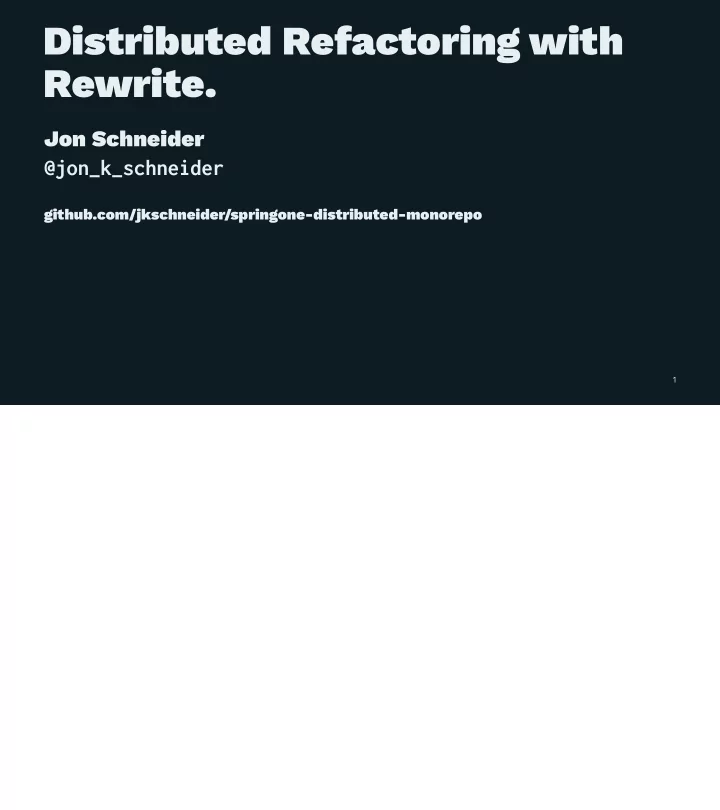

Distributed Refactoring with Rewrite. Jon Schneider @jon_k_schneider github.com/jkschneider/springone-distributed-monorepo 1
Part 1: Rewrite is a programmatic refactoring tool. 2
Suppose we have a simple class A. 3
Raw source code + classpath = Rewrite AST. String javaSource = /* Read A.java */; List<Path> classpath = /* A list including Guava */; Tr.CompilationUnit cu = new OracleJdkParser(classpath) .parse(javaSource); assert(cu.firstClass().getSimpleName().equals("A")); 4
The Rewrite AST covers the whole Java language. 5
Rewrite's AST is special. 1. Serializable 2. Acyclic 3. Type-attributed 6
Rewrite's AST preserves forma ! ing. Tr.CompilationUnit cu = new OracleJdkParser().parse(aSource); assertThat(cu.print()).isEqualTo(aSource); cu.firstClass().methods().get(0) // first method .getBody().getStatements() // method contents .forEach(t -> System.out.println(t.printTrimmed())); 7
We can find method calls and fields from the AST. Tr.CompilationUnit cu = new OracleJdkParser().parse(aSource); assertThat(cu.findMethodCalls("java.util.Arrays asList(..)")).hasSize(1); assertThat(cu.firstClass().findFields("java.util.Arrays")).isEmpty(); 8
We can find types from the AST. assertThat(cu.hasType("java.util.Arrays")).isTrue(); assertThat(cu.hasType(Arrays.class)).isTrue(); assertThat(cu.findType(Arrays.class)) .hasSize(1).hasOnlyElementsOfType(Tr.Ident.class); 9
Suppose we have a class referring to a deprecated Guava method. 10
We can refactor both deprecated references. Tr.CompilationUnit cu = new OracleJdkParser().parse(bSource); Refactor refactor = cu.refactor(); refactor.changeMethodTargetToStatic( cu.findMethodCalls("com.google..Objects firstNonNull(..)"), "com.google.common.base.MoreObjects" ); refactor.changeMethodName( cu.findMethodCalls("com.google..MoreExecutors sameThreadExecutor()"), "directExecutor" ); 11
The fixed code emi ! ed from Refactor can be used to overwrite the original source. // emits a string containing the fixed code, style preserved refactor.fix().print(); 12
Or we can emit a diff that can be used with git apply // emits a String containing the diff refactor.diff(); 13
refactor-guava contains all the rules for our Guava transformation. 14
Just annotate a static method to define a refactor rule. @AutoRewrite(value = "reactor-mono-flatmap", description = "change flatMap to flatMapMany") public static void migrateMonoFlatMap(Refactor refactor) { // a compilation unit for the source file we are refactoring Tr.CompilationUnit cu = refactor.getOriginal(); refactor.changeMethodName( cu.findMethodCalls("reactor..Mono flatMap(..)"), "flatMapMany"); } 15
Part 2: Using BigQuery to find all Guava code in Github 16
Identify all Java sources from BigQuery's Github copy. SELECT * FROM [bigquery-public-data:github_repos.files] WHERE RIGHT(path, 5) = '.java' 17 In options, save the results of this query to: myproject:spinnakersummi t.java_files . You will have to allow large results as well. This is a fairly cheap query (336 GB).
Move Java source file contents to our dataset. SELECT * FROM [bigquery-public-data:github_repos.contents] WHERE id IN ( SELECT id FROM [myproject:spinnakersummit.java_files] ) Note: This will eat into your $300 credits. It cost me ~$6 (1.94 TB). 18
Cut down the sources to just those that refer to Guava packages. Getting cheaper now... SELECT repo_name, path, content FROM [myproject:spinnakersummit.java_file_contents] contents INNER JOIN [myproject:spinnakersummit.java_files] files ON files.id = contents.id WHERE content CONTAINS 'import com.google.common' 19 Notice we are going to join just enough data from spinnakersummit.java_files and spinnakersummit:java_file_contents in order to be able to construct our PRs. Save the result to myproject:spinnakersummit.java_file_ contents_guava . Through Step 3, we have cut down the size of the initial BigQuery public dataset from 1.94 TB to around 25 GB. Much more manageable!
We now have the dataset to run our refactoring rule on. 1. 2.6 million Java source files. 2. 47,565 Github repositories. 20
Part 3: Employing our refactoring rule at scale on Google Cloud Dataproc. 21
Create a Spark/Zeppelin cluster on Google Cloud Dataproc. 22
Monitoring our Spark workers with Atlas and micrometer @RestController class TimerController { @Autowired MeterRegistry registry; @PostMapping("/api/timer/{name}/{timeNanos}") public void time(@PathVariable String name, @PathVariable Long timeNanos) { registry.timer(name).record(timeNanos, TimeUnit.NANOSECONDS); } } 23
We'll write the job in a Zeppelin notebook. 1. Select sources from BigQuery 2. Map over all the rows, parsing and running the refactor rule. 3. Export our results back to BigQuery. 24
Measuring our initial pass. 25
Measuring how big our cluster needs to be. 1. Rewrite averages 0.12s per Java source file 2. Rate of 6.25 sources per core / second 3. With 128 preemptible VMs, we've got: 512 cores * 6.25 sources / core / second 3,200 sources / second = ~13 minutes total We hope... 26
A ! er scaling up the cluster with a bunch of cheap VMs. 27
Some source files are too badly formed to parse. 2,590,062/2,687,984 Java sources = 96.4%. 28
We found a healthy number of issues. — 4,860 of 47,565 projects with problems — 10.2% of projects with Guava references use deprecated API — 42,794 source files with problems — 70,641 lines of code affected 29
Epilogue: Issuing PRs for all the patches 30
Generate a single patch file per repo. SELECT repo, GROUP_CONCAT_UNQUOTED(diff, '\n\n') as patch FROM [cf-sandbox-jschneider:spinnakersummit.diffs] GROUP BY repo 31
Part 2: A stateful CD solution like Spinnaker is key to this in practice. 32
CI and CD have distinct orbits. 33
Maintain a property graph of assets. 34
Increasingly, method level vulnerabilities are available. 35
Thanks for a ! ending! 36
Recommend
More recommend